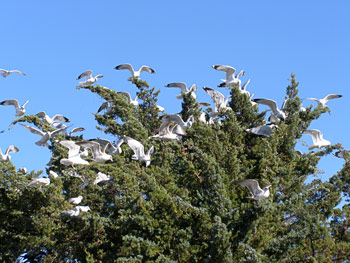Feasting on Ocracoke

A ring-billed gull trying to perch on cedar branches is fun to watch. Photo by Ken Moore
Flora Columnist
I am still relishing attending the Sixth Annual Ocracoke Working Watermen’s Association oyster roast, shrimp boil and fish stew fundraiser on the eve of New Year’s Eve.
The tradition of observing the year’s changeover on Ocracoke Island began 13 years ago for Kathy Buck and me at the invitation of Carrborites David and Terri Swanson, who established their own tradition decades before. This particular year was special in that we were joined by other Carrborites Giles Blunden, Ginger Blakely and Muskie and Vikki Cates.
Hundreds of folks from as far away as Washington, D.C., helped celebrate this group of local fishermen, who, with broad citizen support, succeeded in rescuing the island’s waterfront seafood market and making it a viable base of locally harvested seafood for citizens across the state. (Visit ocracokewatermen.org for more information.)
Also feasting on the island during our visit were hundreds of gulls, mostly ring-billed, participating in a cedar-berry feeding-frenzy for days on end.
Try to imagine a gull perching on a lax cedar branch. Those gulls were actually mostly relying on their wings as they attempted to perch on the coastal red cedar, Juniperus virginiana var. silicicola, to pick off ripe berries.
The predominate tree cover of the Outer Banks is the coastal red cedar, close kin to the common red cedar, Juniperus virginiana, of the mainland. (See “A tale of two cedars†in the Flora archives). For the past 13 years we’ve enjoyed the beauty of the salt-sprayed, wind-sculptured cedars, of which the female specimens are laden with clusters of beautiful blue-gray berries. But this was the first year we’ve observed such frenzied feeding on cedar berries. We are accustomed to seeing cedar waxwings feeding on cedar berries, but gulls – wow!

Gulls in a feeding-frenzy on Ocracoke’s cedar berries. Photo by Ken Moore
I quickly sought a definitive explanation from the numerous birders present for the annual Portsmouth and Ocracoke Island bird counts. The general response was that such frenzied gull-feeding on juniper berries had not been particularly noted before. By contrast, some full-time island residents remembered such gull activity in some years. Some remarked that gulls went after juniper berries when they were starving. Other residents noted that gulls always seem to be starving and will eat anything, anytime.
My need for a specific explanation led me to seek out birder Jeannie Kraus, botanist/ecologist and author of A Guide to Ocean Dune Plants Common to North Carolina. Jeannie had not made particular note of such gull activity, but was definite on the fact that gulls are omnivores. She further inquired of noted expert birder John Fussell III, author of A Birder’s Guide to Coastal North Carolina. John related that ring-billed and laughing gulls in particular occasionally eat berries as well as insects. John Fussell’s birding associate Jack Fennell added that when the gulls’ favorite food, menhaden, is scarce, they go after berries, human food and garbage.
So there you have it. For whatever reason, the gulls are outcompeting cedar waxwings on Ocracoke’s cedar trees this winter.
As for me, I’m still in disbelief after seeing dozens of gulls trying to perch on cedar branches. In the context of the many noted medicinal properties of cedar berries, as well as their use to flavor gin, I’m imagining Ocracoke’s population of gulls being very healthy, or at least very happy, for a few days.
Email Ken Moore at flora@carrborocitizen.com. Find previous Ken Moore Citizen columns at The Annotated Flora (carrborocitizen.com/flora).


Comments are closed.